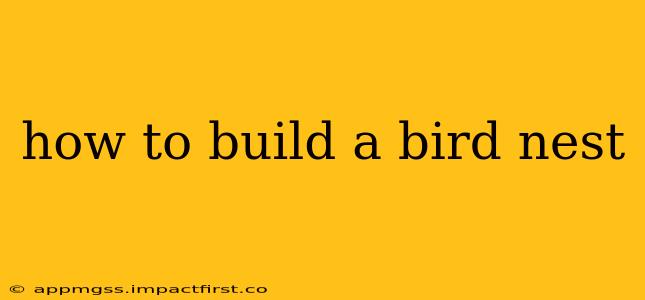Building a bird nest is a marvel of natural engineering, showcasing incredible skill and instinct. While we can't replicate the innate abilities of birds, understanding the process can offer fascinating insights into their behavior and the materials they use. This guide explores the various aspects of nest construction, answering common questions and offering a deeper understanding of this intricate process.
What materials do birds use to build nests?
Birds utilize a diverse range of materials, adapting their choices to their environment and species-specific needs. Common materials include twigs, leaves, grasses, moss, mud, spider silk, feathers, and even human-made items like string or yarn. The selection and arrangement of these materials demonstrate remarkable ingenuity, impacting nest stability, camouflage, and insulation. For instance, some birds use spider silk to bind their nests together, creating a strong and flexible structure. Others incorporate mud to create a protective shell.
How do birds choose a location for their nest?
Nest site selection is crucial for the survival of the offspring. Birds consider several factors, including safety from predators, availability of suitable nesting materials, proximity to food sources, and adequate shelter from the elements. Different species exhibit diverse preferences; some prefer high branches for better visibility, while others opt for concealed locations like tree hollows or dense shrubs. The choice of location often reflects a balance between protection and ease of access to essential resources.
What are the different types of bird nests?
The diversity in bird nest architecture is astounding! There are five main types:
- Cup nests: These are the most common type, shaped like a cup or bowl, and are often made of twigs, grasses, and mud. Many songbirds build cup nests.
- Platform nests: Large, bulky nests constructed on sturdy branches, often using twigs and other coarse materials. Many raptors and some waterfowl build platform nests.
- Cavity nests: Nests built inside cavities in trees, cliffs, or other structures. These offer protection from the elements and predators. Woodpeckers and owls commonly use cavity nests.
- Pendant nests: Hanging nests suspended from branches or other structures, often woven from grasses, plant fibers, and other flexible materials. Some orioles and weaverbirds construct pendant nests.
- Scrape nests: Simple nests consisting of a shallow depression in the ground, lined with minimal materials. Ground-nesting birds like many shorebirds and some game birds create scrape nests.
How long does it take to build a bird nest?
The time it takes to build a bird nest varies significantly depending on the species and the complexity of the nest. Some simple scrape nests might take just a few hours, while more elaborate nests, such as those of weaverbirds, can take several days or even weeks to complete. The construction process often involves both parents, who collaborate on gathering materials and building the structure.
Can I build a birdhouse instead of a bird nest?
While you can't replicate the intricate craftsmanship of a natural bird nest, you can certainly provide birds with a safe and suitable nesting site by building or buying a birdhouse. Birdhouses are particularly helpful for cavity-nesting birds that struggle to find natural cavities. Ensure the birdhouse is appropriately sized for the bird species you intend to attract and positioned in a secure, sheltered location. Avoid disturbing nests once birds have begun using them.
Why is it important to protect bird nests?
Protecting bird nests is crucial for maintaining biodiversity and supporting healthy bird populations. Disturbing nests can lead to nest abandonment, predation, or the death of young birds. Respecting birds' nesting habitats, avoiding disturbing nests, and providing safe nesting options are essential for their survival and contribute to a thriving ecosystem. Remember that human intervention, however well-intentioned, should be minimal to avoid causing harm.
This comprehensive guide provides a detailed understanding of bird nest construction. By respecting and protecting these natural wonders, we contribute to the preservation of biodiversity and the beauty of our natural world. Understanding the intricacies of nest building fosters appreciation for the remarkable skills and instincts of these fascinating creatures.
